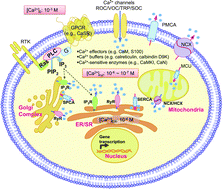Calciomics: integrative studies of Ca2+-binding proteins and their interactomes in biological systems†
Abstract

* Corresponding authors
a Center for Translational Cancer Research, Institute of Biosciences and Technology, Texas A&M University System Health Science Center, Houston, TX, USA
b Department of Chemistry, Georgia State University, Atlanta, GA, USA
c
Department of Biology, Georgia State University, Atlanta, GA, USA
E-mail:
jenny@gsu.edu

 Please wait while we load your content...
Something went wrong. Try again?
Please wait while we load your content...
Something went wrong. Try again?
 Fetching data from CrossRef.
Fetching data from CrossRef.
This may take some time to load.
Loading related content
